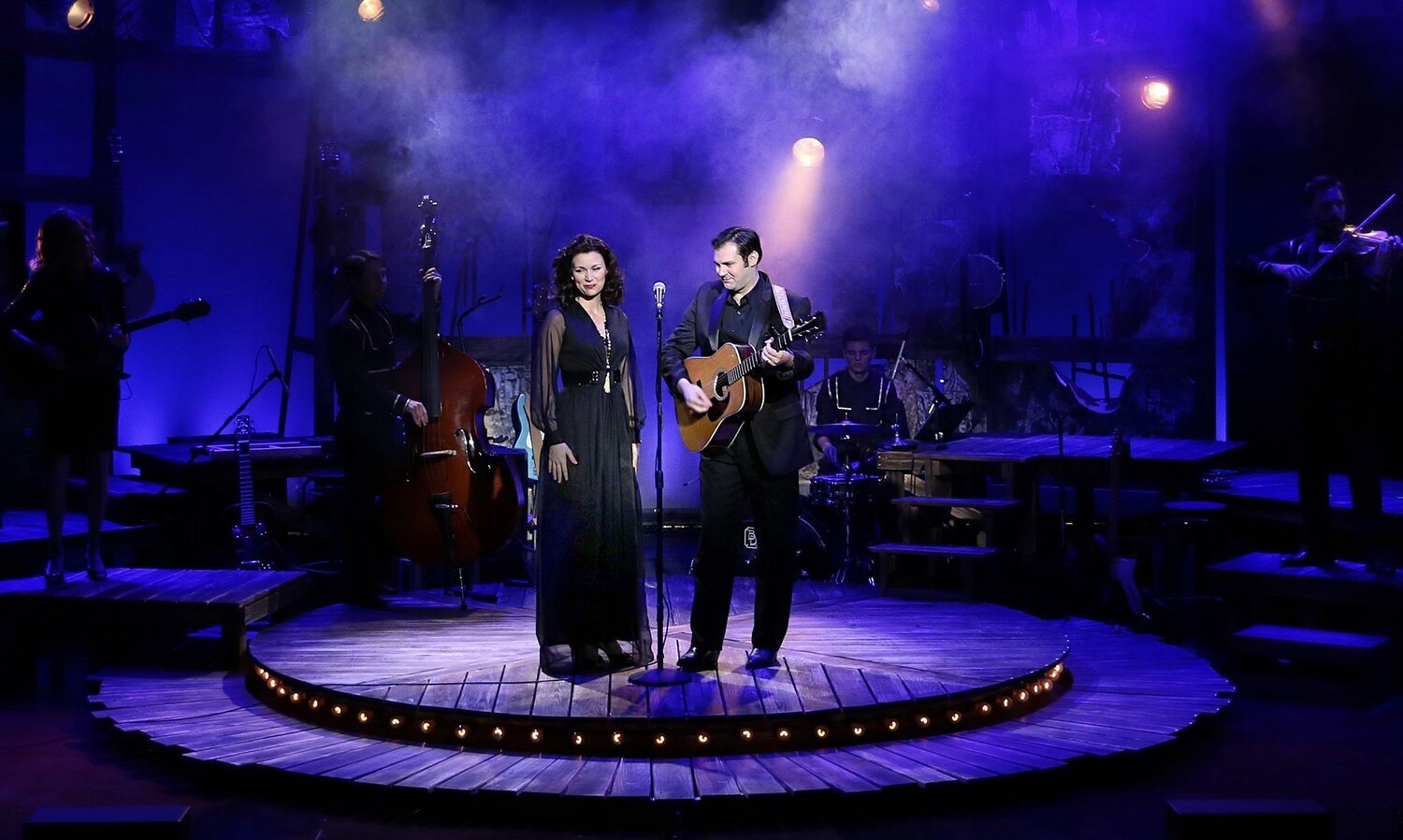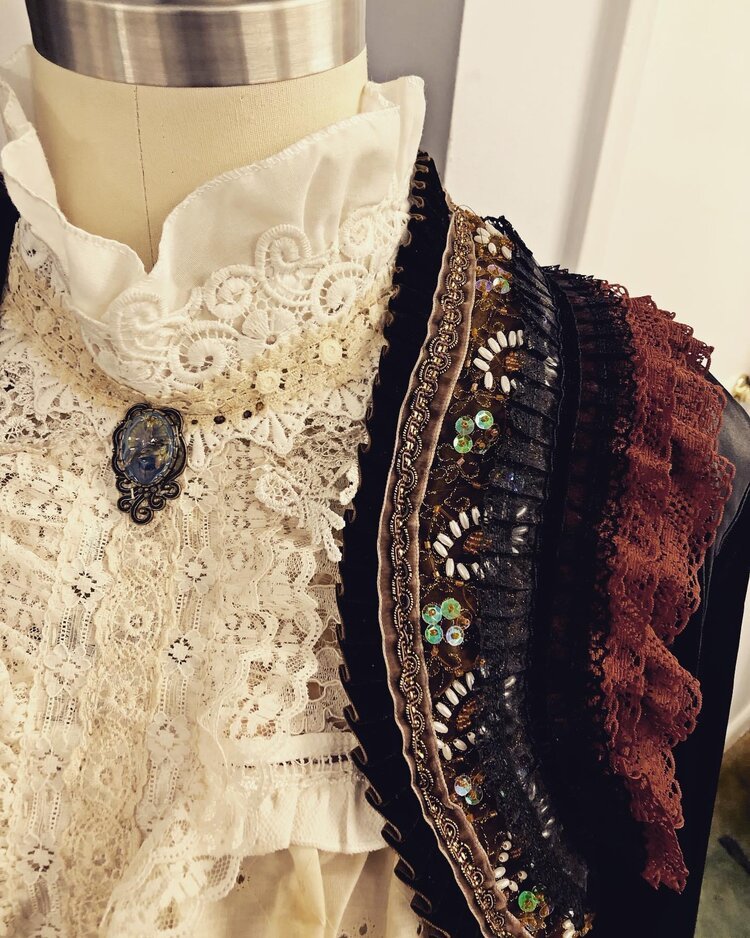By: Kristen P Ahern
June’s #ConsciousHeroOTM is Tristan Raines and our conversation on vintage materials as a tool in his vocabulary as a designer and that the act of modifying a garment is giving it new life, not destruction. Discussing vintage inspires similar conversations about costume stocks and the artistic mindset when considering material vocabulary, collaboration, and success.
Vintage clothing is always present in the life of Tristan Raines both personally and professionally. Often in design conversations, directors will use the word “timeless” and Tristan finds that vintage clothing can be a window into exploring how fashion repeats itself and defining the look of a design. Handling the physical pieces helps really understand the detailing, silhouettes, and fabrics of the clothing. Vintage clothes also already have that “lived in look,” saving resources on distressing. Tristan described one outfit (below) he used in a show that “still had the beat of the club in the fibers,” that it can be a gift to the actor to wear the real thing and create a stronger and more authentic character through costume collaboration. In realizing a design, Tristan tries to consciously use materials that allow for conversation between him and the artists creating the costumes. In a production of Dracula, Tristan used about 18 different vintage Victorian lace pieces stitched together in strips to create a bolero jacket for one of the characters. There can be a journey in refurbishing and finding life in something old to put something new on stage. Tristan notes a critical consideration in putting vintage on stage is longevity. It would be unwise, for example, to put delicate 1920’s dresses on stage in a comedy. However, those dresses could be purchased and provided to the costume artisans for time period accuracy reference.
About a year ago, Tristan posted a photo to Instagram (above) of two vintage dresses spliced together for the character June in Ring of Fire. “I wanted June to feel like a vixen and a goddess and she needed power even if she had little. I found these two vintage dresses from Etsy and over a few days created this new dress by putting two vintage dresses together...When she walked out it was jaw dropping in the moment.” When asked about why they’d gone this route, Tristan explained “For me designing is about authenticity to a character first...We saved maybe $600 doing it this way. The dresses cost about $110 total from Etsy. We then bought about $50 in fabric and a zipper. It took the stitcher about 5 hours to do the work. I paid about $285. Building from scratch would have killed the budget.” Using vintage was both an environmentally and budget conscious choice for this design.
Of course the issue of preservation also comes up around the discussion of vintage or stock pieces. Having a conscious mindset however, can mean going beyond an item’s original function to create something totally new. Tristan has “no problem” cutting up vintage garments to give them new life as a piece of art for the stage. When he was designing Jesus Christ Superstar for the Muny, he used almost entirely vintage or repurposed materials that were cut up, painted, and reassembled to create a totally new look. Successful use of vintage is about incorporating those materials into your design vocabulary. Look at an object for what elements it contains and how it could be transformed rather than just what it is right now. How can we see the potential in making a vintage or second hand item what we want when we can’t find a ready made solution? Having a broad material knowledge helps make choices that are both environmentally and budget conscious.
Tristan pointed out that the conversation we are having over vintage could also apply to any theatres’ costume stocks, for companies that are privileged to maintain a stock. These costume pieces were created to tell the story from the show they were created for, but that story will never be re-told exactly that way so it is essential to reimagine pieces in order to put them on stage again. Frequently theatre company higher ups encourage hoarding stock from popular or favorite shows, or perhaps items that were given to the theatre by treasured donors. We must not be too precious about our collections, after all, we collected it with the intention of one day using it so if we are holding back for fear of it getting damaged then it will continue to go unused. 2020 is magnifying the identity and relevancy crisis that theatre seems to always be in. Lately conversations in the costume professional community have been focused on labor and pay equity, on how costume work can be a sustainable career choice. By repurposing costumes, we are supporting our community by diverting funds from stores directly to the artists who are creating the costumes.
Tristan sees cutting up, refitting, and using found objects in design as a combination of the people he’s worked or studied under. He suggests that now is the time for designers to expand their material vocabulary and hone the skill of creating something out of seemingly nothing. It seems very likely that innovative, environmentally, and cost conscious material use will be crucial in post-Covid costume design. We talked at length about the ecosystem of design after Covid and how budgets, and thus materials, will be a necessary conversation when returning to work. “How can we, as artists, find and come back to that idea of being a storyteller?” Many artists anticipate that budgets will be significantly cut but design is still essential in telling the stories we are trying to tell. How can we go back to the basics of storytelling and embrace the excitement of figuring out how to create our visions with our limited resources? How can innovative material use be a part of that conversation?
Tristan believes we need to have more fundamental conversations through our work and this mass pause is forcing artists to reexamine and find themselves as human beings. We are taking time away to prepare ourselves to be more ready than ever perhaps, returning to theatre is not the path for everyone. Material vocabulary, ethical labor awareness, and finding purpose are all a part of a mindful path forward. We cannot continue defining success as costume designers with one particular path, it is essential that we self evaluate and ask: what is my success?
Instagram: tsbs17
Twitter: Rainestsbs17














